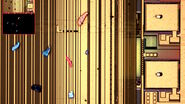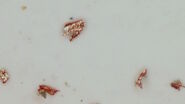Why standards for fluid cleanliness?
Particulate contamination present in lubricating or hydraulic fluids or oils can cause malfunctions or damage to mechanical systems [1-3]. For high-precision systems, like turbochargers used in auto, boat, and airplane motors, quality control of the fluid contamination that occurs during the manufacturing process is done. The fluid is filtered before use and any particles found are then further analyzed.
ISO 4406 and DIN 51455
For most mechanical systems, such as gearboxes of engines and motors or turbines used for offshore wind parks, quality control of the fluid contamination is done after use where the fluid is collected, filtered, and then the particles analyzed. Normally, for both cases, the size of each captured particle is measured and the number of particles determined. The resulting particle size distribution is converted into a comparable and usable form using standardized methods.
The standards ISO 4406 and DIN 51455 define classifications for the degree of particle contamination present in hydraulic fluids and lubricants [4,5]. Also, the NAS 1638 standard was used in the past, but was inactivated in 2001 and replaced by other ones like ISO 4406 [6]. The analysis of particles present in a liquid can be carried out directly on the liquid using electronic or light scattering or extinction methods [7,8] or the particles can be analyzed with a microscope after filtration [5,9].
A complete classification code based on particle analysis with a microscope from ISO 4406 or DIN 51455 would be -/X/Y [4,5]. Each value, X or Y, represents a position in a table of 30 specified particle quantities (refer to table 1 below) which correspond to the number of particles within a reference volume of 100 ml [5] or 1 ml [4]. Each ISO/DIN code value is assigned a particle count range based on whether the particle size is: ≥ 5 µm (X) or ≥ 15 µm (Y) [4,5].
| Number of particles per ml of fluid | Value for | |
| Greater than | Less than or equal to | X (≥ 5 µm) / Y (≥ 15 µm) |
5,000,000 | 10,000,000 | 30 |
2,500,000 | 5,000,000 | 29 |
1,300,000 | 2,500,000 | 28 |
640,000 | 1,300,000 | 27 |
320,000 | 640,000 | 26 |
160,000 | 320,000 | 25 |
80,000 | 160,000 | 24 |
40,000 | 80,000 | 23 |
20,000 | 40,000 | 22 |
10,000 | 20,000 | 21 |
5,000 | 10,000 | 20 |
2,500 | 5,000 | 19 |
1,300 | 2,500 | 18 |
640 | 1,300 | 17 |
320 | 640 | 16 |
160 | 320 | 15 |
80 | 160 | 14 |
40 | 80 | 13 |
20 | 40 | 12 |
10 | 20 | 11 |
5 | 10 | 10 |
2,5 | 5 | 9 |
1,3 | 2,5 | 8 |
0.64 | 1,3 | 7 |
0.32 | 0.64 | 6 |
0.16 | 0.32 | 5 |
0.08 | 0.16 | 4 |
0.04 | 0.08 | 3 |
0.02 | 0.04 | 2 |
0.01 | 0.02 | 1 |
0 | 0.01 | 0 |
Table 1: Values for X (particle size ≥ 5 µm) or Y (particle size ≥ 15 µm) of the classification code where each corresponds to the number of particles per ml of filtered fluid [4,5]. These values are determined by knowing the quantity of fluid which is filtered and counting and analyzing the particles which appear on the filter afterwards.
Let’s take as an example the code -/16/14. The value 16 stands for a total particle count between 32,000 and 64,000 for particles with a size ≥ 5 µm in a fluid volume of 100 ml (equivalent to 320 to 640 particles per 1 ml as shown in table 1). It also means that the fluid contains up to 64,000 particles ≥ 5 µm per 100 ml. The example code also says that the analyzed fluid contains between 8,000 and 16,000 particles with a size ≥15 µm in 100 ml (equivalent to 80 to 160 particles per 1 ml, see table 1).
A filter analysis in accordance with ISO 4406 and DIN 51455 can be carried out with a microscope system using a motorized scanning stage. The automated visual filter evaluation has specific advantages. In addition to the particle sizes, the visual evaluation provides valuable data on the morphology and type of particle. So numerous metallic and non-metallic types of particles can be differentiated. The software delivers analysis results done in accordance with ISO 4406 or DIN 51455. Reports and documentation of the results can also be created quickly and easily.
Cleanliness analysis solutions: Meeting standard requirements efficiently
There are always more and more demands on the performance and reliability of technical systems and components. Current requirements of applicable standards can be reliably fulfilled, but what will they be in the future? A cleanliness analysis solution that can provide information about product quality beyond the current requirements of applicable standards will be able to more easily meet any future changes to the standards. One which can keep up with future needs in this regard is a 2-methods-in-1 materials analysis solution combining optical microscopy and laser-induced breakdown spectroscopy (LIBS). With a 2-in-1 solution, an efficient, seamless workflow, where the particles on a filter are visually examined and then chemically analyzed using LIBS, is achievable [10].
Knowing the particle composition is a big advantage. It helps users to better estimate the potential of particles to cause damage. For hydraulic or lubricating fluids or oils used in high-precision systems with the strictest tolerances, such as turbochargers, the source of particle contamination within the production process can also be narrowed down even further. Ultimately with greater technical cleanliness for hydraulic fluids, lubricants, or oils used in mechanical systems, the quality and reliability of products can be improved, system damage can be minimized, and industrial production processes can be even further optimized.
References
- N. Ecke, Basics in Component Cleanliness Analysis, Science Lab (2017) Leica Microsystems.
- Y. Holzapfel, J. DeRose, G. Kreck, M. Rochowicz, Cleanliness Analysis in Relation to Particulate Contamination: Microscopy based measurement systems for automated particle analysis, Science Lab (2014) Leica Microsystems.
- B. Schroth, J. DeRose, K. Scheffler, K. Kartaschew, More Than Just a Standard, E-Magazine by Direct Industry (2021).
- ISO 4406:2021, Hydraulic fluid power — Fluids — Method for coding the level of contamination by solid particles, International Organization for Standardization.
- DIN 51455:2020-12, Liquid petroleum products - Determination of particle number and particle size in oils, Deutsches Institut für Normung.
- NAS1638, 4th Edition, 2011, Cleanliness requirements of parts used in hydraulic systems, Aerospace Industries Association (AIA).
- ISO 11171:2022, Hydraulic fluid power — Calibration of automatic particle counters for liquids, International Organization for Standardization.
- ISO 11500:2008, Hydraulic fluid power — Determination of the particulate contamination level of a liquid sample by automatic particle counting using the light-extinction principle, International Organization for Standardization.
- ISO 4407:2002, Hydraulic fluid power — Fluid contamination — Determination of particulate contamination by the counting method using an optical microscope, International Organization for Standardization.
- J. DeRose, K. Scheffler, Cleanliness Analysis with a 2-methods-in-1 solution: See the particles and know their composition at the same time, Science Lab (2019) Leica Microsystems.





